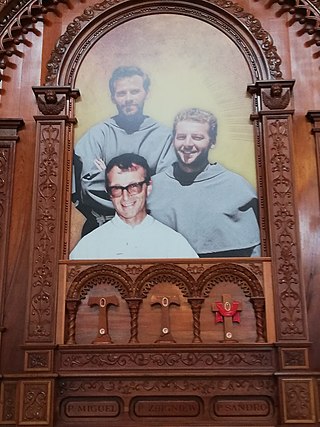
Giovanni di Pietro di Bernardone, known as Francis of Assisi, was an Italian mystic, poet, and Catholic friar who founded the religious order of the Franciscans. Inspired to lead a Christian life of poverty, he became a beggar and itinerant preacher.

Assisi is a town and commune of Italy in the Province of Perugia in the Umbria region, on the western flank of Monte Subasio.

Anthony of Padua, OFM, or Anthony of Lisbon was a Portuguese Catholic priest and member of the Order of Friars Minor.

Peter of Verona, also known as Saint Peter Martyr and Saint Peter of Verona, was a 13th-century Italian Catholic priest. He was a Dominican friar and a celebrated preacher. He served as Inquisitor in Lombardy, was killed by an assassin, and was canonized as a Catholic saint 11 months after his death, making this the fastest canonization in history.

Saint Dominic,, also known as Dominic de Guzmán, was a Castilian Catholic priest and the founder of the Dominican Order. He is the patron saint of astronomers and natural scientists, and he and his order are traditionally credited with spreading and popularizing the rosary. He is alternatively called Dominic of Osma, Dominic of Caleruega, and Domingo Félix de Guzmán, and, in Britain and Ireland, Saint Sunday.

Vincent Ferrer, OP was a Valencian Dominican friar and preacher, who gained acclaim as a missionary and a logician. He is honored as a saint of the Catholic Church and other churches of Catholic traditions.

Angelus of Jerusalem, OCarm was a Catholic convert from Judaism and a religious priest of the Carmelites of the Ancient Observance.

Peter I was the second son of King Sancho I of Portugal and his wife Dulce, infanta of Aragon, and would eventually become Count of Urgell and Lord of the Balearic Islands. Most of what is known about him comes from the Tratado da Vida e Martírio dos Cinco Mártires de Marrocos.

Berard of Carbio was a thirteenth-century Franciscan friar who was executed in Morocco for attempting to promote Christianity. He and his companions, Peter, Otho, Accursius, and Adjutus, are venerated as Catholic saints and considered the Franciscan Protomartyrs. Expelled from the kingdom twice, they returned each time and continued to preach against Islam. In anger and frustration, the king finally beheaded them.

The Basilica of San Domenico is one of the major churches in Bologna, Italy. The remains of Saint Dominic, founder of the Order of Preachers (Dominicans), are buried inside the exquisite shrine Arca di San Domenico, made by Nicola Pisano and his workshop, Arnolfo di Cambio and with later additions by Niccolò dell'Arca and the young Michelangelo.

Daniel and companions were seven Friars Minor martyred at Ceuta on 10 October 1227, according to the Chronicle of the Twenty-Four Generals of the Order of Friars Minor. The names of Daniel's companions are borrowed from the authentic account of the martyrdom of Berard of Carbio and his companions in 1220.

John Forest was an English Franciscan friar and martyr. Confessor to Queen Catherine of Aragon, Forest was burned to death at Smithfield for "heresy", in that he refused to acknowledge the King as head of the church.
Perugia is a city in central Italy, the capital of Umbria.

The Battle of the Puig of 1237, also known as the Battle of the Puig de Santa Maria, the Battle of the Puig de Enesa, or the Battle of the Puig de Cepolla was a battle of the Iberian Reconquista and of the Aragonese Conquest of Valencia.

The Three Martyrs of Chimbote were a group of two Polish Franciscan priests and one Italian missionary priest murdered in Peru in 1991 by the Shining Path communist guerillas. Michał Tomaszek and Zbigniew Adam Strzałkowski, and Alessandro Dordi were murdered on 9 August and 25 August 1991 respectively.
James of Majorca was a member of the House of Barcelona and of the Order of Friars Minor.

The Order of Friars Minor is a mendicant Catholic religious order, founded in 1209 by Francis of Assisi. The order adheres to the teachings and spiritual disciplines of the founder and of his main associates and followers, such as Clare of Assisi, Anthony of Padua, and Elizabeth of Hungary, among many others. The Order of Friars Minor is the largest of the contemporary First Orders within the Franciscan movement.

Blessed Marco da Montegallo was an Italian Roman Catholic priest from the Order of Friars Minor. He was born to a nobleman and served as a doctor in Ascoli Piceno before he was pressured into marriage in 1451 - the couple annulled their marriage after both entered the religious life. Father Marco is best known for establishing pawnshops for the poor across various Italian cities and for being a preacher of love.

Andrea Caccioli was an Italian Roman Catholic priest and a professed member from the Order of Friars Minor. He became the first priest to enter the Franciscans and served as one of the disciples of Francis of Assisi himself - the priest was at his deathbed and attended his canonization. The friar preached across Italian cities such as Rome and Padua as well as in France and he became noted for miracles performed during his lifetime.

Pietro Corradini was an Italian Roman Catholic priest and a professed member of the Order of Friars Minor. Corradini served in several leadership positions within his order which bought him into contact with the likes of James of the Marches and Camilla Battista da Varano - he was her confessor and spiritual director - while in turn being a well-known figure due to his mild mannered nature and for his preaching abilities.


















